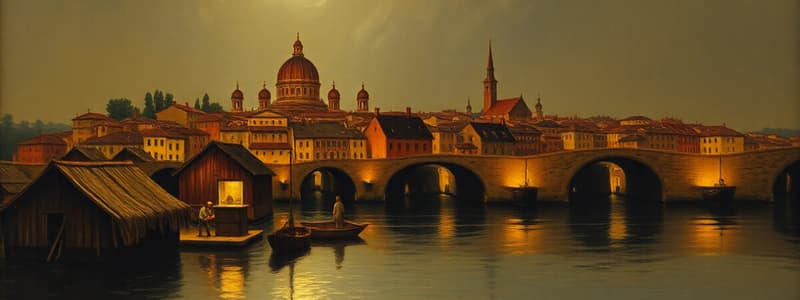Podcast
Questions and Answers
Flashcards are hidden until you start studying
Study Notes
History of Human Settlements
Ancient Times
- Nomadic Lifestyle: Nomads lacked permanent homes, forming small groups (20-30) that wandered in search of food.
- Living Conditions: Early humans lived in the open; occasionally took shelter in trees or caves by rivers, lakes, and springs for protection.
- Mobility: Migration was necessary when food became scarce or gathering resources was difficult.
Transition to Settled Habitation
- Cultivation: Between 10,000 BC to 5,000 BC, humans began practicing agriculture, allowing them to settle near cultivated fields.
- Settlement Preferences: Settlements favored fertile lands with abundant water sources.
- Construction: Development of huts and mud houses marked the transition to semi-permanent settlement.
Community and Social Structure
- Emergence of Traders: Traders, often from hunting tribes, became community leaders, accumulated wealth, and gained knowledge through travel.
- Social Stratification: The establishment of social classes began with traders ascending to positions of power as chieftains.
- Physical Structure of Settlements: Wealthier individuals built homes near the chieftain’s castle, creating a divide between rich and poor in the community.
Defensive Measures
- Walled Settlements: Walls were constructed around settlements to protect against human threats, leading to higher population density.
- Conflict Over Resources: As wealth disparity grew, tensions between rich and poor increased, necessitating fortifications.
Neolithic Cities (7000 – 9000 BC)
- Jericho: Featured a well-organized community of about 3,000 people, enclosed by a circular stone wall, reliant on a freshwater source.
- Khirokitia: An early settlement in Cyprus with no streets, characterized by circular structures and a central social area.
- Çatalhöyük: A large Neolithic city in Turkey with a population of 10,000, known for trade, specialized crafts, and a complex layout.
Notable Ancient Cities (2000 – 4000 BC)
- Mesopotamia: Cities formed around the Tigris and Euphrates rivers, including Eridu (oldest city) and Babylon (largest with 80,000 inhabitants).
- Egyptian Civilization: Cities along the Nile, such as Thebes and Memphis, showcased monumental architecture and organized irrigation systems.
Indus Valley Civilization (2500 BC)
- Mohenjo-Daro and Harappa: Advanced urban centers with a grid layout, sophisticated sanitation, and evidence of religious administrative functions.
Chinese Civilization (1900 BC)
- Anyang: The largest city in the Yellow River Valley, an early example of a linear city structure.
Settlements in the Americas
The English Renaissance
- Planned Cities: Cities like Savannah (designed by James Oglethorpe) and Annapolis featured civic squares and governmental buildings as focal points.
Speculator’s Town
- Philadelphia: Designed by William Penn, development driven by speculation and planning based on guesswork.
The Industrial Revolution
- Machine Age: Marked a significant shift from manual labor to assembly line production.
- Schools of Thought: Emerged during this era included reform movements and specialized approaches to urban design.
Studying That Suits You
Use AI to generate personalized quizzes and flashcards to suit your learning preferences.




